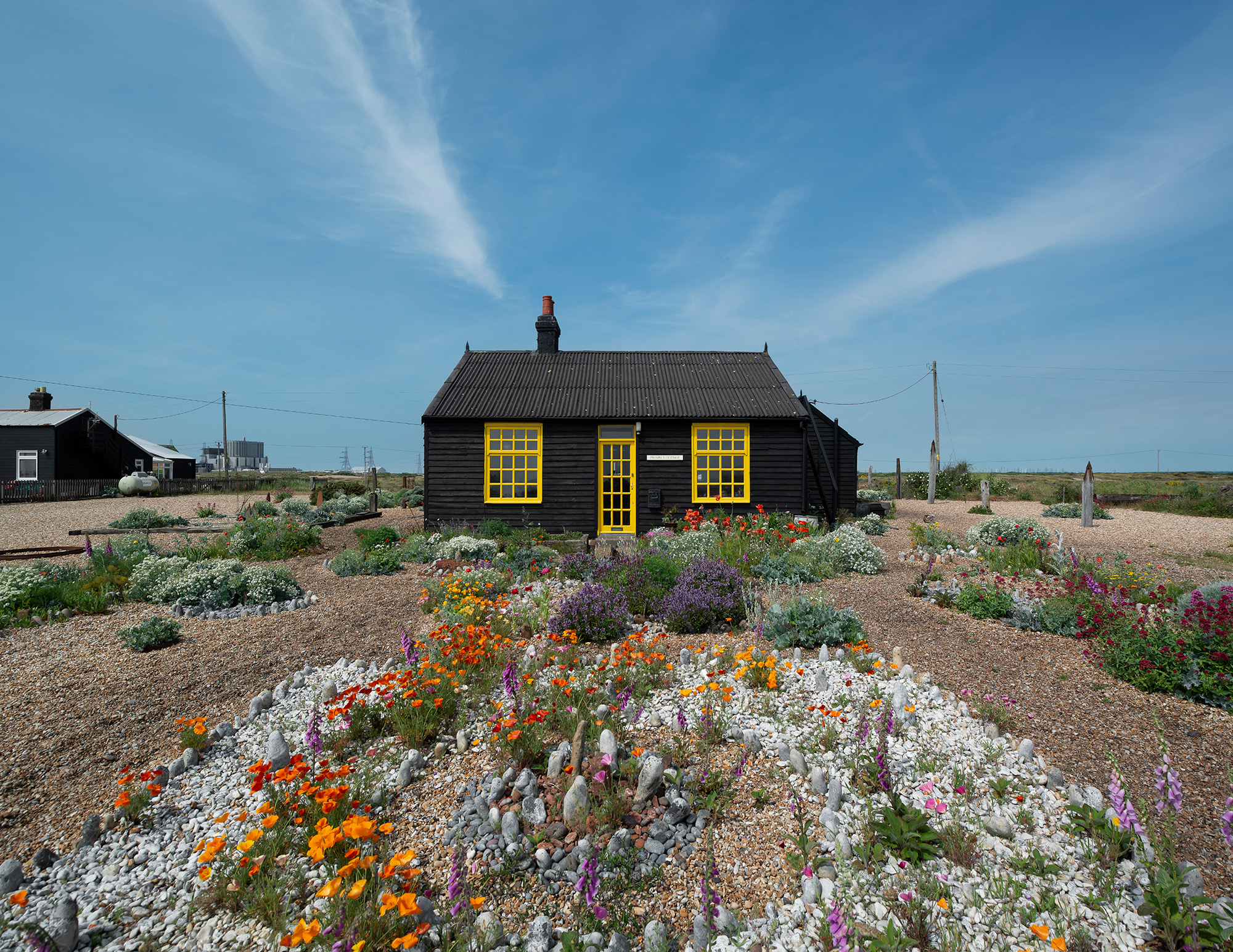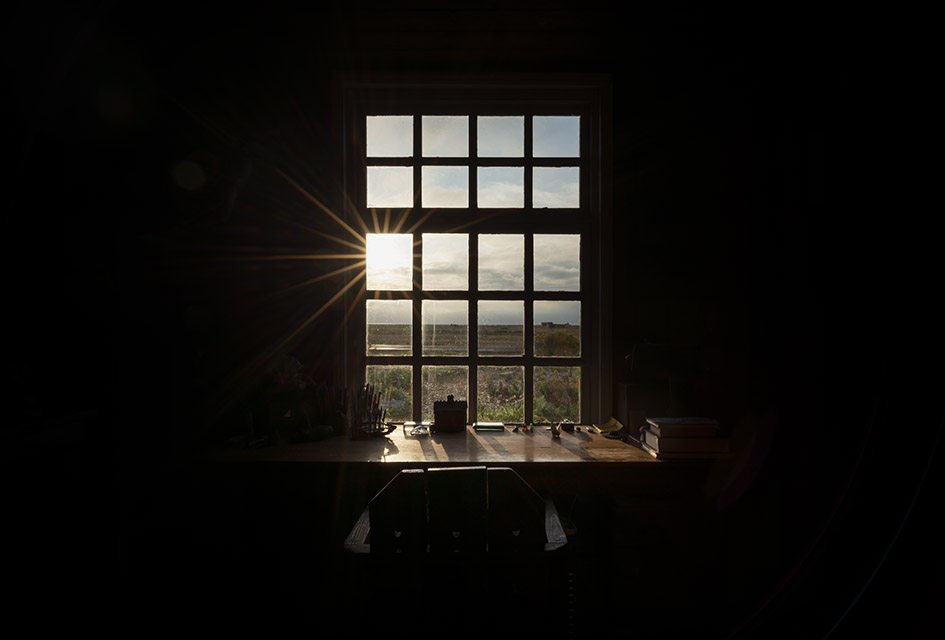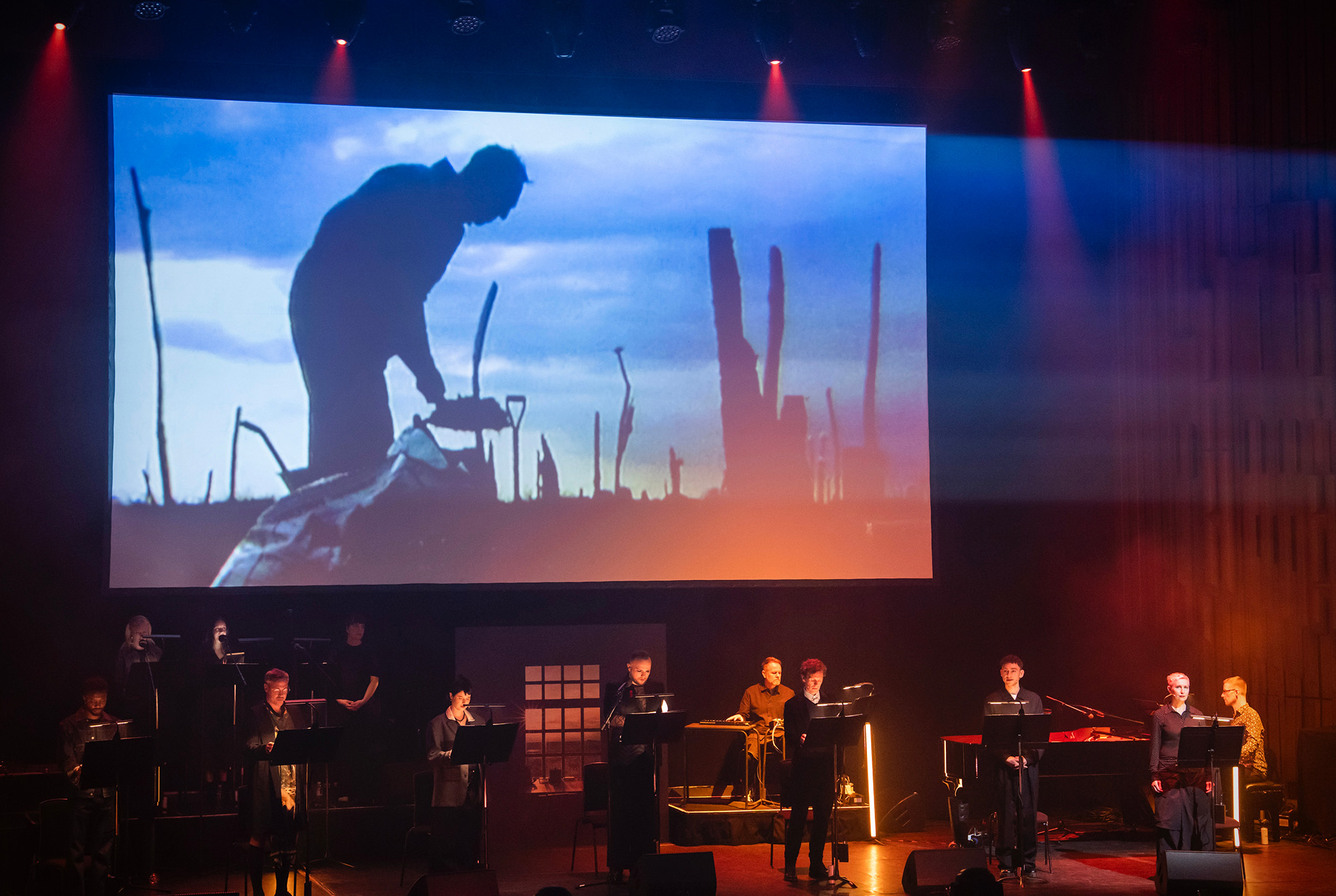Poetically tending Derek Jarman’s garden: Modern Nature at
the Barbican
In an event at London’s Barbican, 16 performers came
together to create a poetic gesture towards Derek Jarman’s Prospect Cottage &
garden at Dungeness. Will Jennings went along to the atmospheric, loving reinterpretation
of the auteur artist’s words, film & domestic project.
“We inspected the ruined shacks with their tightly drawn
curtains; there are many more of them for sale this year, their occupants have
abandoned them to the wind, uneasy. The estate agent’s Xerox calls them ‘cottages’:
perhaps shanties would be more appropriate, or hovels.
I take the camera out on the shingle and Tilda runs round in a circle following the beam of the lighthouse which turns without ceasing. We knock at the door of Prospect Cottage, a tiny wooden fisherman’s house displaying a ‘For Sale’ notice, which tosses and turns in the gale. The view is shingle and sea, no fence or garden to cut it off. From the back a wide empty expanse of scrubland with the nuclear power station.”
![]()
It was 1986, the year of his HIV diagnosis, when Derek Jarman first saw Prospect Cottage, he was in Dungeness filming scenes for The Last of England, his 1987 cinematographic mashup raging against Thatcherism, the anti-gay Section 28, and the political destruction of English culture. In the last scene of the film Tilda Swinton swirls like a Dervish on the pebbles, perhaps recalling that moment the actress partnered with the lighthouse light a year before. Dungeness would come to be singularly connected to the auteur, particularly because having bought Prospect Cottage with money inherited after his father’s death, it would be the place he spent the remaining years of his life until his own 1994 death of an AIDS-related illness.
![]()
fig.ii
But more than a place to passively pass as winds and waves
shifted the shore, he turned the shanty into an active place of energy,
culture, creativity, nature, and life – qualities the place still has today not
only in memory through Jarman’s 1990 film The Garden and in the pages of
his journals reproduced as Modern Nature and Slow Motion, but
still as an active place of making. After the Art Fund purchased Prospect Cottage
in 2020, nearby cultural body Creative Folkestone have acted as custodians,
opening the place and its garden to the public and overseeing residencies for
artists and filmmakers.
![]()
“Dungeness was so silent. Only the sound of the wind. ‘Does the wind ever stop?’ I asked the sweet lady who owned the house. ‘Sometimes,’ she replied.”
At the Barbican, the character of the place was put on stage with Derek Jarman: Modern Nature, a poetic weaving of music, reading, song, and visuals. The cottage itself was ever present, an enlarged Gilbert McCarragher photograph central on the stage, a view from a dark interior looking across Jarman’s silent desk towards a radiant sun dancing back over flat desert beach.
In front of it, six readers read passages from Jarman’s Modern Nature diaries over continuous music important to the artist or used in his works. Each reader is Jarman, but loosely reflects a kaleidoscopic element of his character through his words, and each – Shaun Evans, Jessie Buckley, Omari Douglas, Will Young, Olly Alexander, and Jessica Walker – carries his words differently. What unifies them, though, is how they sit in relationship to the music and the narrative arc of Jarman’s illness, his tending of the garden, the psychology of weather, and the presence of the power station as Dungeness’s singular non-shanty monolith.
![]()
“There are no walls or fences. My garden’s boundaries are the horizon. In this desolate landscape the silence is only broken by the wind, and the gulls squabbling round the fishermen bringing in the afternoon catch.
There is more sunlight here than anywhere in Britain; this and the constant wind turn the shingle into a stony desert where only the toughest grasses take a hold – paving the way for sage-green sea kale, blue bugloss, red poppy, yellow sedum.”Derek Jarman, Modern Nature: Journals, 1989 – 1990 (The Journals of Derek
Jarman, 1) London: Vintage.
![]()
I take the camera out on the shingle and Tilda runs round in a circle following the beam of the lighthouse which turns without ceasing. We knock at the door of Prospect Cottage, a tiny wooden fisherman’s house displaying a ‘For Sale’ notice, which tosses and turns in the gale. The view is shingle and sea, no fence or garden to cut it off. From the back a wide empty expanse of scrubland with the nuclear power station.”
Derek Jarman, Kicking the Pricks. London: Vintage.

fig.i
It was 1986, the year of his HIV diagnosis, when Derek Jarman first saw Prospect Cottage, he was in Dungeness filming scenes for The Last of England, his 1987 cinematographic mashup raging against Thatcherism, the anti-gay Section 28, and the political destruction of English culture. In the last scene of the film Tilda Swinton swirls like a Dervish on the pebbles, perhaps recalling that moment the actress partnered with the lighthouse light a year before. Dungeness would come to be singularly connected to the auteur, particularly because having bought Prospect Cottage with money inherited after his father’s death, it would be the place he spent the remaining years of his life until his own 1994 death of an AIDS-related illness.

fig.ii

fig.iii
“Dungeness was so silent. Only the sound of the wind. ‘Does the wind ever stop?’ I asked the sweet lady who owned the house. ‘Sometimes,’ she replied.”
Derek Jarman, Kicking the Pricks. London: Vintage.
At the Barbican, the character of the place was put on stage with Derek Jarman: Modern Nature, a poetic weaving of music, reading, song, and visuals. The cottage itself was ever present, an enlarged Gilbert McCarragher photograph central on the stage, a view from a dark interior looking across Jarman’s silent desk towards a radiant sun dancing back over flat desert beach.
In front of it, six readers read passages from Jarman’s Modern Nature diaries over continuous music important to the artist or used in his works. Each reader is Jarman, but loosely reflects a kaleidoscopic element of his character through his words, and each – Shaun Evans, Jessie Buckley, Omari Douglas, Will Young, Olly Alexander, and Jessica Walker – carries his words differently. What unifies them, though, is how they sit in relationship to the music and the narrative arc of Jarman’s illness, his tending of the garden, the psychology of weather, and the presence of the power station as Dungeness’s singular non-shanty monolith.

fig.iv
|
The sublime power of weather, especially in remote or desolate places, recurs in British art as a leitmotif of the soul and psyche. Benjamin Britten, JMW Turner, John Constable, Maggi Hambling, Paul Nash, Tacita Dean, and others compress depression, despair, abandonment, hope, and release into atmospheric studies of sky, land, and water. Here, the music acts like a cloud, forming into loud storm carrying Cumulonimbuses, dissipating into a wispy Cirrus cover, breaking into Stratocumulus patches, then filling the atmosphere of the Barbican’s main hall into a Stratus fog. Through it all, projected on a large screen behind all the musicians and singers – including Jarman collaborator Simon Fisher Turner, Kele Okereke of Bloc Party, and Icelandic electronic wizard Valgeir Sigurðsson – presented footage from Jarman’s films. The garden is present throughout, in visuals, words, and feeling, the death, decay, care, nurture, and regrowth of the small patch of shrubland planting reflecting the care that Jarman received from his partner Keith Collins, and which he gave to the world through his work.  fig.vAs the artist lost his sight, as the virus attacked his immunity, as he worked to create in ways his body would still allow, the garden remained central to his being. When he was forced into a prolonged stay in St Mary’s Hospital after his AIDS diagnosis, a recurring concern bothered him: “I worry about my garden.” The British garden is often presented as the cliché perfect lawn, the Capability Brown improved vista, the manicured, polite, mannered, and sculpted. But Jarman’s is truer, and aligned the marginalised and repressed, downtrodden and ill, hopeful and creative. It speaks to an ongoing act of maintenance to let that which can survive, flourish. To not control or corral, but gesture and support as it grows, to tend and love even in the harshest, loneliest, most seemingly-barren times.  fig.viWhile not a small production, with 16 people on stage involved in the choreography of sounds, it was not bombastic or pretentious. Even the baroque flourishes of countertenor Nils Wanderer and theatrics from Olly Alexander didn’t distract from what was, as all nature is, an ensemble. It was generous, and reminds that even within grand visions of singular artistic visionaries, it is a more collaborative, collective, mannered contemplation that can produce the most meaningful, poetic, and still political ways of rendering the world. Just, indeed, as Derek Jarman tended in his garden, films, words, and home at Dungeness. |
“There are no walls or fences. My garden’s boundaries are the horizon. In this desolate landscape the silence is only broken by the wind, and the gulls squabbling round the fishermen bringing in the afternoon catch.
There is more sunlight here than anywhere in Britain; this and the constant wind turn the shingle into a stony desert where only the toughest grasses take a hold – paving the way for sage-green sea kale, blue bugloss, red poppy, yellow sedum.”
Derek Jarman, Modern Nature: Journals, 1989 – 1990 (The Journals of Derek
Jarman, 1) London: Vintage.

fig.vii
Prospect Cottage is the former home and sanctuary of artist,
filmmaker, gay rights activist and gardener Derek Jarman (1942 - 1994).
Following a successful campaign to save the cottage for the nation, you can now
step inside the home and workspace of one of Britain's most iconic creative
figures. As custodians of Prospect Cottage, Creative Folkestone are proud to be
able to offer limited visits to this inspiring place.
www.creativefolkestone.org.uk/prospect-cottage
Bold Tendencies is a not-for-profit arts organisation based in the rooftop spaces at Peckham Multi-Storey Car Park in South London.
Since 2007 it has transformed a disused building in the city into an experimental civic space and much-loved place of assembly.
Bold Tendencies celebrates the free enjoyment of public space in the city, welcoming participation in its rich, experimental programme.
www.boldtendencies.com
Gilbert McCarragher is an artist and photographer, and author of ‘Prospect Cottage: Derek Jarman’s House’, published by Thames & Hudson
Gilbert’s architectural photography is featured extensively in books and magazines including El Croquis, Domus and John Pawson Plain Space (2010).
As an artist, he works in multiple photographic mediums, and has exhibited at the Royal Academy of Arts, Victoria and Albert Museum, Institute of Contemporary Art (London), Jerwood Space and the Wapping Project.
www.gilbertmccarragher.com
www.boldtendencies.com


